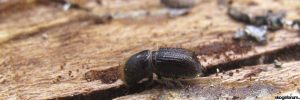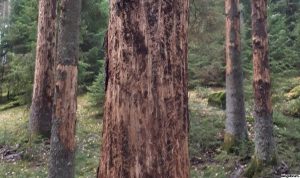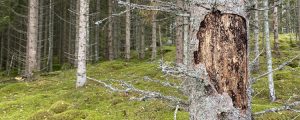Two storms in south Sweden have caused over two million cubic meters of windthrow. Added to that, there is severe snow damage locally in some regions. The coming summer can become a nightmare for bark-beetle fighters.
A nightmare for Swedish forest owners
Soon the bark-beetle will wake up and get on with what they do best, eating spruce bark and killing spruce trees. The conditions for the beetles are good due to storms and snow damage in combination with, so far, very dry spring in south Sweden. What is a dream for the bark-beetles is a nightmare for the forest owners if no action is taken. The “action” so far in the war against the bark-beetle, has been information campaigns. Now, more tangible actions are needed to prevent the bark-beetle from taking over.
Eight of ten affected trees from 2021 are still in the forest
Last year showed that we (Sweden) didn´t have control of the bark-beetle situation. The damages were just as big as in 2020 with 8 million cubic meters of killed forest. In some parts of Sweden, 2021 was even worse than the year before. This, even though some leading scientists by the end of 2020 claimed that they saw a decrease in the bark beetle’s reproduction rate for 2021. Now, the same scientists say that the reproduction rate was higher than they thought it would be in 2021 and that the number of killed trees risks increase even further in 2022.
There are a record number of bark-beetles in the trees now, just waiting to get out there and attack the spruce trees in April/May when the heat comes.
Useless campaigning
The campaign made by the Swedish Forest Agency and the forest industry seems to have had no effect at all. According to an inventory made by SLU, the Swedish University of Agricultural Sciences, commissioned by the Forest Agency, 80 percent of the bark-beetle-affected spruce trees were still in the forest by the end of 2021. All of them are full of overwintered bark-beetles and larvae waiting for the spring.
Windthrow is prioritized fry herds as they are more weakened than the standing trees. To leave large volumes of windthrow in the forests of south Sweden during 2022 will contribute to a major reproduction of the bark-beetle. There is a risk that the damages in 2022 will be the worst ever. Time is running fast, and the forest owners must work hard to get the affected trees out of the forest ASAP.
Why did it go wrong in 2021?
There are probably many reasons for the failed bark-beetle hunt in 2021. The above-mentioned campaign is one. Maybe it would have been better to take more tangible actions instead? Traps, trap logs, debarking, and chemical treatment is some examples of actions to limit the damages of the bark-beetle. These kinds of actions were taken by many other European countries, but not in Sweden. Why?
One theory is the good year for the Swedish forest industry, not least the sawmills. Also, the pulp industry had a very good year in 2021. Altogether, this meant that the industry needed more timber than a normal year. Working with damaged forests takes time as the trees are spread out over large areas and you also must search for them. It’s much more efficient to fell fresh trees, so that’s was what was done. The results were a record annual felling in Sweden of estimated 96 million cubic meters, and most of the affected spruce trees were left in the forest.
Will 2022 be better?
Ahead of this year’s bark-beetle attack both the authorities and the wood buyers in Sweden must shape up. Compared to many other countries in Europe, the damages in Sweden have been modest but the trend is going in the wrong direction. To break that trend the strategy must be changed. To hope for a wet and cold summer will not help. It’s all about getting as much affected wood out of the forest while the bark-beetle are still asleep in it.
Many private forest owners don’t have the knowledge, the equipment, or the time it takes to do the job themselves. Therefore, they need help from the wood buyers and their forest machine contractors. If it turns out to be difficult for the wood buyers to focus on the affected wood, maybe new regulations are needed to force the companies to prioritize? According to the Forestry Act, 3 cubic meters of the storm- or bark-beetle-damaged wood per hectare are allowed to leave and it’s the Forest Agency who is responsible for supervising this.
In the long run, no one gains from a situation where large parts of the mature spruce forest are wiped out in southern Sweden, even a year like 2022 when the sawmills will give full gas and sell lumber at high prices, and it will be tempting to go for the fresh timber instead of the damaged.
Could self-employed forest owners be the solution?
Some wood buyers have special bark-beetle assortments to make it easier for self-employed forest owners to handle the timber. Maybe more wood buyers should offer that solution? Maybe the sawmills should actively search for buyers of blue-stained lumber (which is not desired by Swedish sawmills today)?
If the wood buyers find it difficult to find time to help forest owners take care of bark-beetle wood, they could offer a good price for special bark-beetle assortments. That would probably get more forest owners out in the woods with their chainsaws and log trailers.
Photos: Skogsforum.se
This is a summary of an article at Skogsforum.se signed by Torbjörn Johnsen














